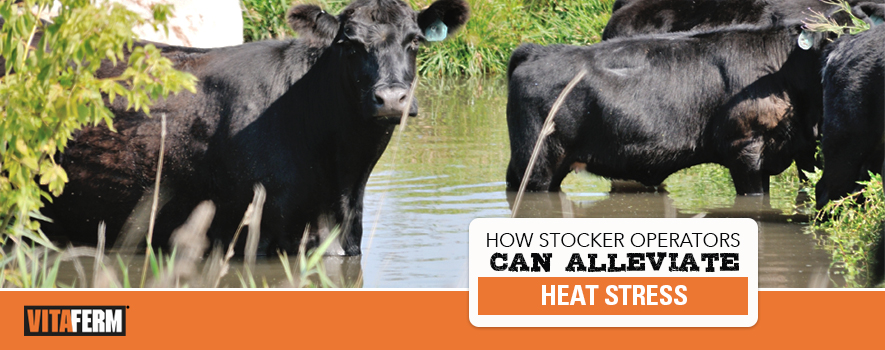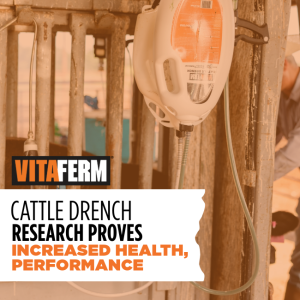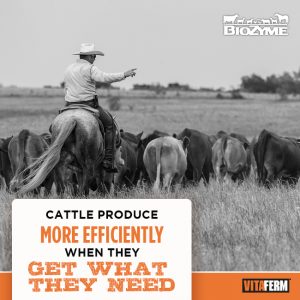
Summer heat takes its toll on your entire herd, with a decrease in performance, the potential for increased sickness and economic losses. But for stocker calves, in their prime growth period, the added stress from heat can magnify those challenges even more so.
The degree of heat stress is typically measured by a temperature-humidity index (THI) and this threshold varies based on the production stage of the animal. For stockers the threshold THI for moderate stress is about 84-degrees, where it might be about 5 degrees lower for a lactating cow. The duration of extreme temperatures also plays a role in the way heat stress impacts stockers. Therefore, there is no one size fits all approach to solving the heat-stress challenges.
“The unfortunate part is everybody’s situation is different based on regional climate differences,” said Kevin Glaubius, Director of Nutrition for BioZyme® Inc. “Where a backgrounder in Texas might have to deal with severe heat for seven months, someone in North Dakota might have extreme heat for just two months. However, the commonality is understanding the cascade of events that go on with heat stress – symptoms to look for and what to do.”
The first visible sign of heat stress you should look for is an increased respiration rate. According to Glaubius, this increased respiration leads to increased air volume intake, which can ultimately lead to other sicknesses in the calves. With increased air intake, the calves are inhaling more dust, dirt, bacteria and viruses into their bodies.
The second sign of heat stress, and one most commonly thought of, is calves that seek out shade and water during the heat of the day. This disrupts the normal feeding pattern of continuously grazing and consuming smaller meals. That disruption shifts to night grazing and slug feeding where they eat more at once due to increased hunger. Slug feeding leads to acidosis and bloat, which can lead to more health issues. When they bunch up during the day, they also are more likely to be exposed to sickness because of shared germs – think of containing school kids in an enclosed room with no fresh air.
“Metabolically, the cells are working harder, when the calves’ respiration increases, so those cells have to be replaced more often. Microbes have a life cycle of minutes – maybe 90 minutes – so disruption of eating during the day starves the microbes from their growth pattern, which is why this is a great time to introduce a prebiotic like Amaferm® into the calves’ diets,” Glaubius said.
Amaferm®️ is a prebiotic designed to enhance digestibility by amplifying the nutrient supply for maximum performance. It is research-proven to increase intake, digestion and absorption. Feeding Amaferm during heat stress has multiple benefits including improved digestibility, increased energy availability, improved rumen function, and less loss of performance. The improved digestibility observed with Amaferm feeding provides more energy to the animal during heat stress when intake is reduced.
In ideal conditions, when heat stress isn’t a challenge, and voluntary feed intake exists, Glaubius said typically 70-percent of the diet goes toward maintenance while 30-percent will go to gain. During times of extreme heat, those numbers change, and 80-percent of intake goes toward maintenance, and only 20-percent goes to gain, costing the stocker operator lost performance over time.
That’s why it is imperative to keep your calves as cool as possible and regulate their grazing habits, keeping them eating regularly and performing. Glaubius offers suggestions for caring for stockers during the hot summer months.
- If you do need to work or treat any sick calves, do so early in the day when the temperatures are the coolest.
- Any physical exercise like moving calves from pasture to pasture, needs to be done in the early morning during the coolest part of the day.
- Provide adequate shade. If trees are available great. If you are feeding small groups of calves, consider portable shade options or build your own shade options if in pastures or lots you use each year.
- Provide cool, fresh water. Water intake is directly correlated to feed intake. If your calves only water source is a pond where the calves are bunching to stay cool, consider putting in a tank with fresh well water flow so the calves get fresh water that they haven’t stood in.
- Provide a high-quality vitamin and mineral supplement like VitaFerm® Gain Smart® Stocker HEAT® to keep the calves healthy, cooler and growing.
Melynda Gress, Y-Cross Inc., is supplementing her yearlings in northwest South Dakota with the Gain Smart Stocker HEAT this year. In addition to keeping her calves healthier, Gress also noticed a significant difference in their heat tolerance, growth and fly control when using the HEAT mineral.
“With the HEAT product, it was so nice because the yearlings – which are really tough to run because they tend to shade up, stand in water holes and are not really good about grazing – they are out grazing in the heat of the day, and the flies are not bothering them. Not a bit,” she said.
Prior to the VitaFerm Gain Smart Stocker adding HEAT, Gress fed the VitaFerm HEAT last spring and summer and noticed significant increases in performance. Gress said 2017 was a very challenging year for her stockers, that rely solely on the cool-season grasses and mineral. They were in a drought most of the summer, and yet her calves that she normally sells around 800-900 pounds each fall, weighed more than 925 pounds, thanks to her mineral program.
Ideally suited for backgrounding and yearling cattle on grass, VitaFerm Gain Smart Stocker HEAT contains Capsaicin, research-proven to help maintain normal body temperature and support animal performance and gain in both heat and fescue situations. It also includes Amaferm which is shown by research to increase average daily gains, improve the variation in dry matter intake and improve both animal health and rumen health, and garlic, to deter insects.
“Research proves that with Amaferm in the diet, cattle producers typically see a quarter-pound of increased gain per day. Combine that with the HEAT mineral components, and that has the potential to increase to a half-pound per day,” Glaubius said.
Stocker operators face challenges, but with proper management and a good nutrition program, heat stress doesn’t have to be one of those challenges. Although calf comfort isn’t a measurable trait, keeping calves eating, healthy and growing gives the backgrounder added opportunities for increased performance and increased profits.


